Try these community-centered election strategies from the Tennessean
David Plazas, The Tennessean,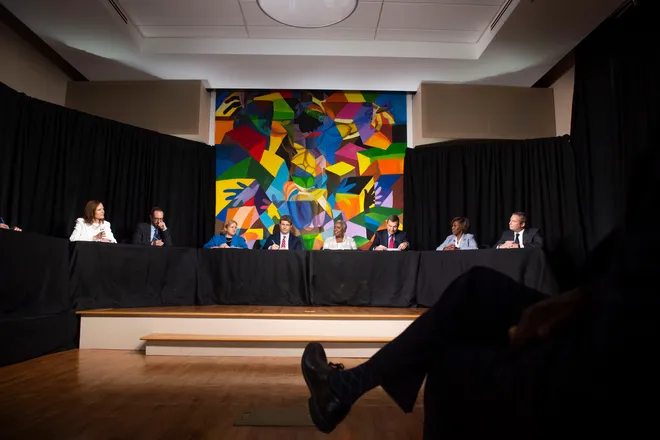
Mayoral candidates answer questions during the third Nashville Mayoral Debate at American Baptist College in Nashville, Tenn. on Thursday, July 6, 2023. (Nicole Hester/The Tennessean)
By taking this approach for local elections, the news organization created a significant, authentic public service experience around local politics.This is a series on Better News to a) showcase innovative/experimental ideas that emerge from the Knight-Lenfest Newsroom Initiative and b) share replicable tactics that benefit the news industry as a whole.
This “win” comes from David Plazas, director of opinion and engagement for the USA TODAY Network Tennessee. The Tennessean participated in the Major Market Table Stakes program in 2020-21.
The Tennessean, in Nashville, Tenn., sought to be the leader of news, information and commentary around the 2023 city mayoral and Metro Council election. We have a history of covering local politics and know that local issues are where our journalism has the most impact and potential to drive new audience and subscriptions.
The Tennessean editorial board connected candidates to voters, provided the largest platform for ideas to be debated and created both top-of-the-funnel and in-depth content to attract and delight longtime and new readers. The planning began in September 2022, a year before the runoff election and involved creating partnerships, building relationships and creating content and events on multiple platforms: web, social media, video and the debate stage.
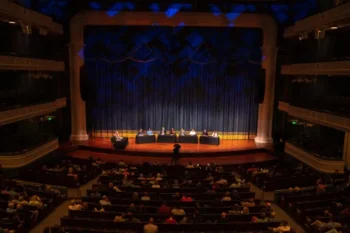
Candidates participate in the second Nashville Mayoral Debate at Belmont University Thursday evening on June 22, 2023.
The editorial board comprises the newspaper’s editor, opinion and engagement editor, regional editor, race and justice editor, and conservative columnist. The board decided not to endorse candidates in 2023, which resulted in greater credibility and trust from readers and ensured that the mayoral candidates – some Republican and some Democratic (though it’s a nonpartisan race) – participated in debates and interviews. This was especially important in an open mayoral race that featured 12 candidates.
The opinion side never sought to scoop news reporting but collaborated closely to ensure successful coordination of coverage, events and analysis. The editorial team did not rush its process or publication but was deliberate in planning and in monitoring metrics to grow readership and attract new subscribers.
Here are four highlights from our election coverage:
Candidate questionnaires that were meaningful but brief

The survey sent to all 106 candidates in the 2023 Nashville municipal election.
What we did and why: We sent all 106 municipal candidates a questionnaire that asked for biographical information and
posed 12 questions on local relevant issues. We have crafted a candidate questionnaire for the past few years and modified it for specific races. We published them online shortly after the May 18 candidate qualifying deadline and created four print candidate guides in our opinion section. The digital versions had individual links and were also housed on a landing page. In addition, all mayoral candidates were invited to The Tennessean to do a video interview.
What worked well: 92% of candidates filled out a questionnaire and none who failed to do so won their race. The questionnaire drove tens of thousands of page views and hundreds of news subscriptions. We intended this as a long-tail win. Data from past elections held true this time: There was a slow pickup upon publication with a spike at the start of early voting, a few days before the election and on Election Day. The payoff was tremendous and allowed us to exceed company goals on impact.
Opinion content historically has performed at a modest level compared with breaking news and sports, for example. The baseline for a successful opinion article for us is a minimum 1,000 page views and opinion content that influences four new subscribers is considered a win.
The top 50 pieces of opinion content related to the municipal election generated 241,416 page views between May 24 (day of publication) and Sept. 15 (day after the runoff election), or an average of about 4,800 page views per column. The top three page views performers related to the questionnaires were:
- Meet Freddie O’Connell (who won the mayoral election): 21,935 page views
- Learn about the Metro Council At-Large candidates: 15,891 page views
- Meet Alice Rolli (runner up in the election): 14,945 page views
In terms of subscriptions, 60 opinion columns or articles met the minimum threshold of four with an average of 27 new subscriptions for those particular pieces. There are the top three:
- Learn about candidates running in the Aug. 3 Nashville mayoral election | Editorial (186 subscriptions)
- Struggling to pick a Nashville mayoral candidate? This scorecard might help. | Plazas (124 subscriptions – more on this article below)
- Learn about candidates running in the Aug. 3 Metro Council At-Large election | Editorial (89 subscriptions)
What didn’t work as expected: Getting the candidates to fill out the questionnaire was a chore. It took multiple calls and emails to ensure that we would make our deadlines for publication. This is a time-consuming process.
Try this:
- Start planning as early as possible and reach out to candidates when they declare.
- Coordinate with designers, audience team and news side to ensure maximum reach.
- Create an assortment of a mix of simple-to-answer questions and others that require more reflection to create variety for the candidate and reader.
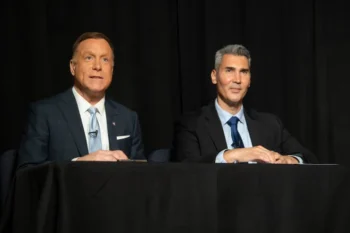
Rhori Johnston of NewsChannel 5 and David Plazas of The Tennessean ask questions to candidates during the third Nashville Mayoral Debate at American Baptist College in Nashville, Tenn. on Thursday, July 6, 2023. (Nicole Hester/The Tennessean)
Debates made possible by partnerships
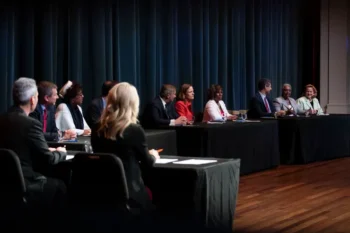
Mayoral candidates answer questions during a debate for the Nashville mayoral candidates at Fisher Performing Arts Center in Nashville, Tenn. on Thursday, May 18, 2023. (Nicole Hester/The Tennessean)
What we did and why: The Tennessean led the creation of The Nashville Mayoral Debates, the premiere debate series of the 2023 mayoral election. We organized four debates from May through August in partnership with local television news leader News Channel 5, Belmont University, American Baptist College and the League of Women Voters of Nashville.
What worked well: Early planning was essential to the success of these events. The mayoral race became an open contest
because the incumbent mayor chose not to seek re-election. History showed us that groups all over town would seek to produce forums with the candidates. We committed the candidates to our debate schedule early. Our university partners provided space, green rooms, security and ticketing. News Channel 5 provided extensive promotion and publicity. The League added credibility as a trusted civic group, but they would not have joined with us had we chosen to endorse a candidate for mayor. The debates were highly viewed and drove top-read news coverage of each event.
What didn’t work as expected: Having 12 candidates in the race was too many for good television, and we made the difficult decision of limiting the number of candidates: Nine in the first one and eight in the subsequent two. The final debate featured the two runoff candidates. The choice to limit participation created hard feelings among some campaigns and members of the public – and opened the door to criticism of us as elitist gatekeepers.
Try this:
- Identify and reach out to partners early and ensure that their vision is aligned to yours.
- Create a criteria for participation (polling, funds raised, current elected official, etc.).
- Be in contact with attendees before and after the event to remind them to support your journalistic efforts.
Scorecards that met the audience’s needs
What we did and why: While the questionnaires offered an important public service, our metrics showed they were generally a middle- or bottom-of-the funnel play (save for the spikes mentioned above). Reporting and anecdotal experience showed our editorial board that there was a consumer demand for shorter-form information on the candidates. We would get asked whom to vote for because many members of the public knew we were interacting with the candidates intensively and often. Thus, was born the Nashville Mayoral Candidate Scorecard.
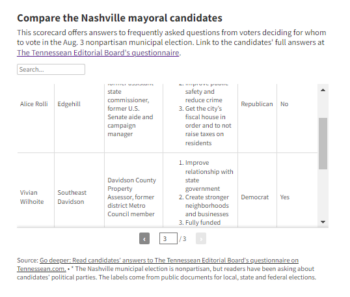
The candidate scorecard allowed Tennessean readers to compare mayoral candidates on a five questions including past political experience and top priorities.
We created a chart that we embedded in a column that compared the candidates on these five items: neighborhood, occupation, political affiliation, elected office experience, and their top three priorities (taken from the questionnaires). That allowed readers to compare their own views and priorities to those of the candidates. It created game-ification and encouraged critical thinking. Plus, they could link to more in-depth content if they wished.
What worked well: This was a user-friendly, extremely well-read and useful service that drove audience and subscriptions and it was developed by listening and not trying to over-complicate a solution for readers. We applied this approach effectively for the At-Large Metro Council candidates in a separate column and also created short videos for each article. An opinion intern created social cards with scorecard information to share on Instagram as posts and stories.
Metrics (between May 24 to Sept. 15):
- Mayoral scorecard: 7,433 page views, influenced 124 subscriptions
- Metro Council At-Large scorecard (embedded in candidate Q&A): 15,891 pages views, influenced 89 subscriptions
What didn’t work as expected: This was a happy surprise that worked amazingly well. We should have thought of it earlier.
Try this:
- Plan for multiple engagement approaches to election journalism from the long form to the short-term charts.
- Listen to the public about what matters to them and integrate that into your approach.
- Promote constantly.
An opinion section that facilitates conversation
What we did and why: This is a fundamental role of an opinion page or section: welcome diverse viewpoints and amplify underrepresented views. We invited candidates and the public to submit letters to the editor and guest opinion essays to talk about issues that mattered to them in the election.
What worked well: The approach affirmed our values as an editorial dedicated to being the ultimate water cooler.
What didn’t work as expected: Only one mayoral candidate submitted a guest opinion column and our metrics showed readers were not gravitating to this type of content anyway. Our data show that what readers wanted was information about the candidates, their positions and backgrounds – and the questionnaires and scorecards met that need. The topics that trended for guest opinion essays around the time of the Aug. 3 election had to do with high profile news, be it the Jason Aldean “Small Town” controversy or the special Tennessee legislative session on firearms laws. That does not mean we will stop soliciting commentary, but we need to keep our focus on content that engages and informs and analysis/opinion that responds to the news of the day.
Try this:
- Invite the public and candidates often to comment on the issues of the day.
- Be open to the unexpected because what we journalists may feel is important is not always the case for all readers. Pivot.
- Keep track of metrics, experiment and try unique approaches to sharing positions from video to short-form writing to social media posts.